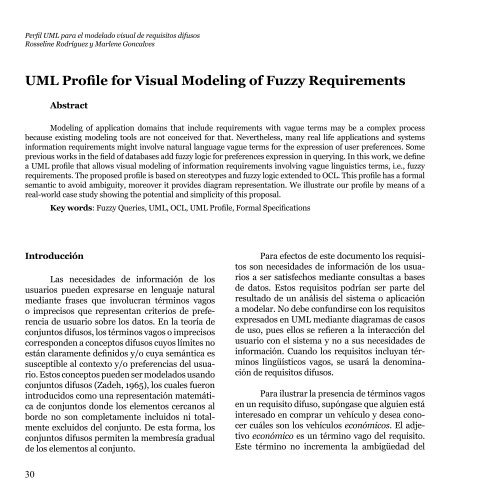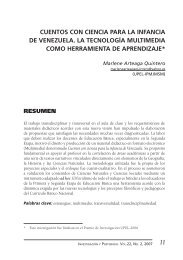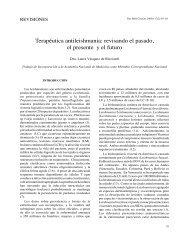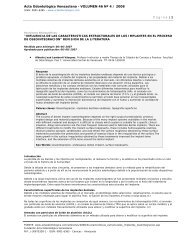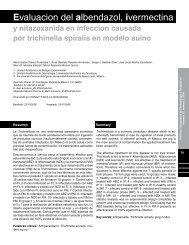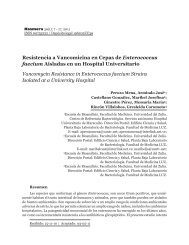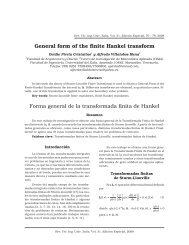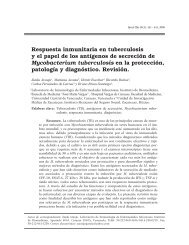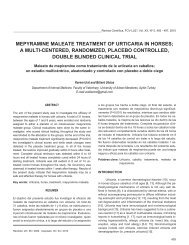Perfil UML para el modelado visual de requisitos difusos - Dialnet
Perfil UML para el modelado visual de requisitos difusos - Dialnet
Perfil UML para el modelado visual de requisitos difusos - Dialnet
You also want an ePaper? Increase the reach of your titles
YUMPU automatically turns print PDFs into web optimized ePapers that Google loves.
<strong>Perfil</strong> <strong>UML</strong> <strong>para</strong> <strong>el</strong> mod<strong>el</strong>ado <strong>visual</strong> <strong>de</strong> <strong>requisitos</strong> <strong>difusos</strong><br />
Ross<strong>el</strong>ine Rodríguez y Marlene Goncalves<br />
<strong>UML</strong> Profile for Visual Mod<strong>el</strong>ing of Fuzzy Requirements<br />
Abstract<br />
Mod<strong>el</strong>ing of application domains that inclu<strong>de</strong> requirements with vague terms may be a complex process<br />
because existing mod<strong>el</strong>ing tools are not conceived for that. Neverth<strong>el</strong>ess, many real life applications and systems<br />
information requirements might involve natural language vague terms for the expression of user preferences. Some<br />
previous works in the fi<strong>el</strong>d of databases add fuzzy logic for preferences expression in querying. In this work, we <strong>de</strong>fine<br />
a <strong>UML</strong> profile that allows <strong>visual</strong> mod<strong>el</strong>ing of information requirements involving vague linguistics terms, i.e., fuzzy<br />
requirements. The proposed profile is based on stereotypes and fuzzy logic exten<strong>de</strong>d to OCL. This profile has a formal<br />
semantic to avoid ambiguity, moreover it provi<strong>de</strong>s diagram representation. We illustrate our profile by means of a<br />
real-world case study showing the potential and simplicity of this proposal.<br />
Key words: Fuzzy Queries, <strong>UML</strong>, OCL, <strong>UML</strong> Profile, Formal Specifications<br />
Introducción<br />
Las necesida<strong>de</strong>s <strong>de</strong> información <strong>de</strong> los<br />
usuarios pue<strong>de</strong>n expresarse en lenguaje natural<br />
mediante frases que involucran términos vagos<br />
o imprecisos que representan criterios <strong>de</strong> preferencia<br />
<strong>de</strong> usuario sobre los datos. En la teoría <strong>de</strong><br />
conjuntos <strong>difusos</strong>, los términos vagos o imprecisos<br />
correspon<strong>de</strong>n a conceptos <strong>difusos</strong> cuyos límites no<br />
están claramente <strong>de</strong>finidos y/o cuya semántica es<br />
susceptible al contexto y/o preferencias d<strong>el</strong> usuario.<br />
Estos conceptos pue<strong>de</strong>n ser mod<strong>el</strong>ados usando<br />
conjuntos <strong>difusos</strong> (Za<strong>de</strong>h, 1965), los cuales fueron<br />
introducidos como una representación matemática<br />
<strong>de</strong> conjuntos don<strong>de</strong> los <strong>el</strong>ementos cercanos al<br />
bor<strong>de</strong> no son completamente incluidos ni totalmente<br />
excluidos d<strong>el</strong> conjunto. De esta forma, los<br />
conjuntos <strong>difusos</strong> permiten la membresía gradual<br />
<strong>de</strong> los <strong>el</strong>ementos al conjunto.<br />
Para efectos <strong>de</strong> este documento los <strong>requisitos</strong><br />
son necesida<strong>de</strong>s <strong>de</strong> información <strong>de</strong> los usuarios<br />
a ser satisfechos mediante consultas a bases<br />
<strong>de</strong> datos. Estos <strong>requisitos</strong> podrían ser parte d<strong>el</strong><br />
resultado <strong>de</strong> un análisis d<strong>el</strong> sistema o aplicación<br />
a mod<strong>el</strong>ar. No <strong>de</strong>be confundirse con los <strong>requisitos</strong><br />
expresados en <strong>UML</strong> mediante diagramas <strong>de</strong> casos<br />
<strong>de</strong> uso, pues <strong>el</strong>los se refieren a la interacción d<strong>el</strong><br />
usuario con <strong>el</strong> sistema y no a sus necesida<strong>de</strong>s <strong>de</strong><br />
información. Cuando los <strong>requisitos</strong> incluyan términos<br />
lingüísticos vagos, se usará la <strong>de</strong>nominación<br />
<strong>de</strong> <strong>requisitos</strong> <strong>difusos</strong>.<br />
Para ilustrar la presencia <strong>de</strong> términos vagos<br />
en un requisito difuso, supóngase que alguien está<br />
interesado en comprar un vehículo y <strong>de</strong>sea conocer<br />
cuáles son los vehículos económicos. El adjetivo<br />
económico es un término vago d<strong>el</strong> requisito.<br />
Este término no incrementa la ambigüedad d<strong>el</strong><br />
30


